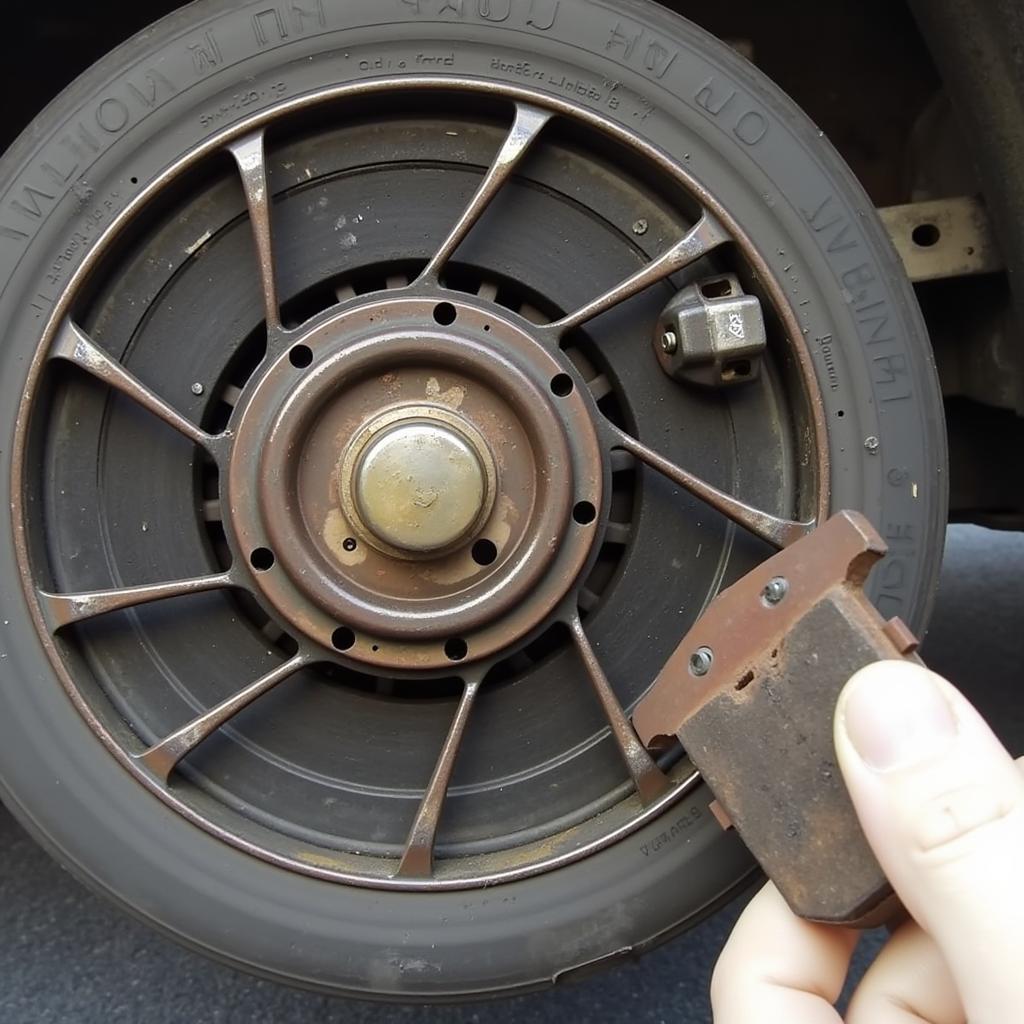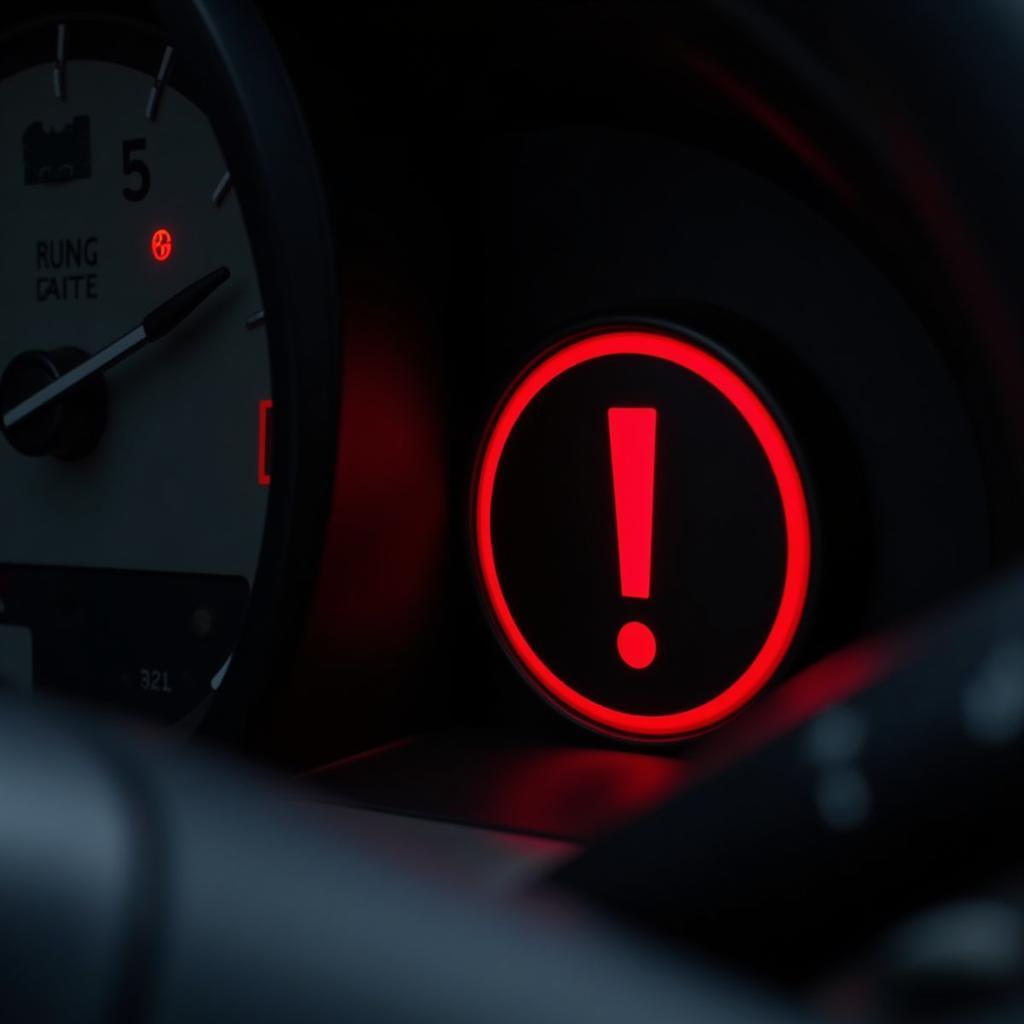The parking brake warning light on your dashboard is a crucial safety feature. It’s designed to alert you if your parking brake is engaged or if there’s a potential issue within the braking system. Seeing it illuminated while driving can be unnerving, but don’t panic. This comprehensive guide will walk you through the common causes and provide step-by-step instructions on how to reset a parking brake warning light.
Common Causes of a Parking Brake Warning Light
Before diving into the reset process, it’s essential to understand why your parking brake warning light might be on. Here are some typical culprits:
- Engaged Parking Brake: The most obvious reason is that you haven’t fully disengaged the parking brake.
- Faulty Brake Fluid Sensor: Your car utilizes a sensor to monitor brake fluid levels. If this sensor malfunctions or detects low fluid, it can trigger the warning light.
- Worn Brake Pads: Brake pads naturally wear down over time. When they reach a certain level of wear, the brake pad sensor will trigger the warning light.
- Electrical Issues: Problems like a blown fuse, loose wiring, or a malfunctioning dashboard cluster can also cause the parking brake light to illuminate.
How to Reset a Parking Brake Warning Light: A Step-by-Step Guide
Here’s a general guide on how to reset your parking brake warning light:
- Check the Parking Brake: Ensure the parking brake is fully disengaged. Sometimes, a slight bump or incomplete release can be the culprit.
- Inspect Brake Fluid: Locate your brake fluid reservoir (refer to your car’s manual) and check the fluid level. If it’s low, add the appropriate brake fluid, ensuring it meets the specifications outlined in your owner’s manual.
- Visual Inspection: If you’re comfortable, take a look at your brake pads. If they appear significantly worn, it’s best to consult a mechanic.
- Reset Procedure: If the previous steps haven’t resolved the issue, you can attempt a manual reset. This procedure varies depending on the car model but usually involves a combination of turning the ignition on/off, pressing the brake pedal, and engaging/disengaging the parking brake. Refer to your owner’s manual for specific instructions.
“Modern vehicles are equipped with sophisticated self-diagnostic systems,” says automotive engineer, Sarah Chen. “In many cases, simply addressing the underlying problem will automatically reset the warning light.”
When to Seek Professional Help
While the steps above can often resolve simple issues, it’s crucial to seek professional help if:
- The Light Persists: If the warning light remains on after trying the reset or if it reappears frequently, there could be a deeper underlying problem requiring professional diagnosis and repair.
- You Notice Braking Issues: Any changes in your brake pedal feel, such as sponginess, unusual noises (grinding, squealing), or reduced braking performance, warrant immediate attention from a qualified mechanic.
Understanding Diagnostic Tools and Remote Software
In today’s technologically advanced automotive landscape, diagnostic tools and remote software play a significant role in troubleshooting and resolving car issues, including those related to the parking brake system.
-
OBD2 Scanners: These handy devices plug into your car’s OBD2 port (usually located under the steering wheel) and can read diagnostic trouble codes stored in your vehicle’s computer. These codes provide valuable insights into the potential causes of the warning light, allowing mechanics to pinpoint the issue accurately.
-
Remote Software Solutions: Certain automotive software programs enable remote diagnostics and even software updates. These programs allow mechanics to access your car’s computer system remotely, analyze data, and identify problems, sometimes even before they become noticeable.
“Remote diagnostics are transforming the way we approach car repairs,” explains automotive software specialist, Mark Thompson. “They offer a quicker, more efficient way to diagnose issues, potentially saving car owners time and money in the long run.”
Preventing Future Parking Brake Warning Light Issues
While some causes of a parking brake warning light are unavoidable due to normal wear and tear, proactive measures can minimize their occurrence:
- Regular Maintenance: Adhere to your vehicle’s recommended maintenance schedule for brake fluid flushes, brake inspections, and pad replacements.
- Engage Parking Brake Gently: Avoid forcefully engaging or disengaging the parking brake.
- Address Warning Lights Promptly: Don’t ignore any warning lights on your dashboard, especially those related to your braking system. Addressing them early can often prevent more significant problems down the line.
Conclusion
Understanding how to reset a parking brake warning light can empower you to address a common car issue. However, remember that this guide provides general information, and specific procedures may vary based on your car make and model. Always refer to your owner’s manual for precise instructions.
If you’re ever in doubt or encounter persistent issues, don’t hesitate to seek assistance from a qualified mechanic. Your safety and the optimal performance of your vehicle should always be a top priority.
FAQ
1. Can I drive with the parking brake light on?
It’s not advisable to drive with the parking brake light on, especially if you suspect the brake is engaged. Doing so can lead to brake damage, reduced fuel efficiency, and potential safety hazards.
2. How often should I check my brake fluid?
It’s good practice to visually inspect your brake fluid level at least once a month.
3. How long do brake pads last?
Brake pad lifespan varies depending on driving habits and conditions. However, they typically last between 30,000 to 70,000 miles.
4. Is it expensive to replace a brake fluid sensor?
The cost of replacing a brake fluid sensor depends on the make and model of your car. However, it’s generally an affordable repair.
5. Can I reset the parking brake warning light myself?
While you can attempt a manual reset, it’s crucial to consult your owner’s manual for specific instructions for your vehicle model. If unsure, seeking professional assistance is recommended.


